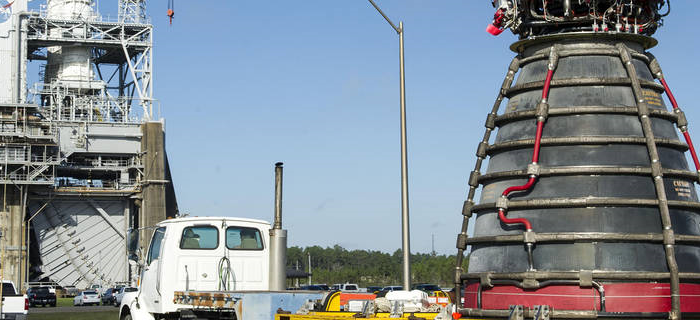First RS25 flight engine test set for March

NASA is about to reach another milestone in the development of its Space Launch System (SLS.) The SLS is designed to take humans on future deep space missions, and the heart of the system is the RS-25 engine. March 10th will be the first test of this flight-model engine, which will be the most powerful rocket in the world, once in its final configuration.
SLS is the future of space flight for NASA. It's planned uses include missions to Mars and to an asteroid. The rockets for the system have to be powerful, and they have to have a proven track record. The RS-25 fits the bill: they are a high-performance system that has seen much use.
The RS-25 has been used on over 135 shuttle missions, and they have seen over 1 million seconds of hot-fire time during ground testing. For the SLS, four RS-25s will be used to generate over 2 million pounds of thrust, and they will operate in conjunction with two solid rocket boosters.
"This year is all about collecting the data we need to adapt these proven engines for SLS's first flight," says Steve Wafford, the SLS Engines Manager. The team conducted a series of tests on a developmental RS-25 engine last year, but this is the first one that will fly.
Ronnie Rigney is the RS-25 project manager at the Stennis Space Center, where the tests are being conducted. "Every test is important, but there really is a different energy level associated with flight engines. It's hard to describe the feeling you get knowing you're going to see that engine lift off into the sky one day soon. It's a very exciting time for all of us here," said Rigney.
The SLS will be built in 3 stages, called blocks:
- Block 1 will have a 70 metric ton lift capability.
- Block 1B will be more powerful for deeper missions and will have a 105 metric ton lift capability.
- Block 2 will add a pair of solid or liquid propellant boosters and will have a 130 metric ton lift capability.
Each of these blocks will use 4 RS-25 engines, and in its Block 2 configuration it will be the most powerful rocket in the world.
Engine #2059 is more than just a test engine. It will be used on the second SLS exploration mission (EM2), which will carry 4 astronauts into lunar orbit to test the SLS spacecraft.
"You can't help but be excited about the test on A-1 (test stand,) especially when you realize that the engines that carried us to the moon and that carried astronauts on 135 space shuttle missions were tested on this very same stand. We're just adding to a remarkable history of space exploration," said Stennis Space Center Director Rick Gilbrech.
The team at Stennis feels the characteristic enthusiasm that NASA is known for. "We're not just dreaming of the future. We're enabling it to happen right now," said Rigney.
Though the March 10th test is definitely a milestone, there's still lots more work to do. Testing on RS-25 engines and flight controllers will continue, and in 2017, testing of the core stage will take place. 4 RS-25 engines will be tested at the same time.
That will be quite a sight.
Source: Universe Today





















